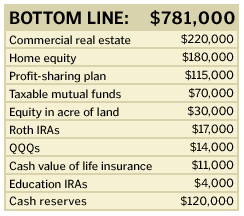
NEW YORK (CNN/Money) -
Fourteen years ago, Tom and Mary Kemnitz decided their money habits had to change. They had about $10,000 in debt, all from credit cards, and no savings. And they realized that carrying the debt forever meant throwing away their chance at a comfortable retirement.
Today, they're well on their way to putting their feet up. They lost the credit card debt and boast a bottom line totaling $781,000. Tom and Mary, both 39, look forward to spending their golden years full-time in the great outdoors, as they already do on their weekends with son Tanner, 9, and daughter Madison, 5.

"A big part of [our lifestyle change] had to do with tolerating the stress of working," Mary said. "To work hard and not feel you were getting anywhere wasn't acceptable. If we're going to endure job stress, we need to feel as though we're building some equity also."
Making a clean break
Their first step was to decide on a few ground rules. They would set annual goals each January and hit them by the end of the year, if not sooner. And Tom keeps tabs on their net worth every month.
"It's not like one of us wants to retire early, and the other one wants to go to Hawaii," Tom said. "We have a good relationship that helps us work on this together."
The Kemnitzes have their own business, Xerographics of Northern Arizona, a sales agency for Xerox Corp., in Flagstaff, Ariz. Tom started with Xerox in 1986, right after college. He went to work with an independent agent two years later, during which time Xerox paid him solely on commission based on the products he sold. Mary and he became agents themselves in 1992, and incorporated their business in 1994.
Today, their business has a profit-sharing plan that allows both Tom and Mary to put away 25 percent of their pre-tax salary. It acts like a 401(k) or retirement plan - the money grows tax-deferred and can't be withdrawn until they hit age 59-1/2. So far, they've accumulated about $115,000 in the profit-sharing plan, with 70 percent in stocks and 30 percent in bonds.
"When we incorporated, we set ourselves up on salaries of $36,000 and didn't change them for 5 years, despite how well the business did. Anytime we had a windfall, we'd pay the principal to our mortgage," Tom explained. Their home in Flagstaff is now worth about $360,000, and they have $180,000 in equity. As for their current salaries, the most they'll take now is $50,000 each.
Tom and Mary also own the building where they do business. It's a small, commercial property, about 1,400 sq. feet, and they bought it 5 years ago for $126,000. They made oversized payments on the mortgage for about 4.5 years, and paid it off. The property is now worth $220,000.
A third property is a piece of raw land, which they bought last year. It's an acre of forest property, worth about $65,000. They have $30,000 in equity, and estimate they'll own it free and clear in 6 months, if they decide to use some of their cash reserves to pay for it.
"Tanner will be ready for college in 9 years, when the lot should be worth $90,000 to $100,000. We can sell it and put half towards his education expenses, and half can be invested in a bond fund for Maddie's college education," Tom explained.
The kids also have Education IRAs, each with $2,000, and any money given to the kids as gifts gets invested in Treasury bonds for college.
Tom and Mary also have a total of $17,000 invested in Roth IRAs, his and hers. They have $11,000 invested in a life insurance policy. Taxable funds - a mid-term bond fund and an S&P 500 Index fund - hold another $70,000. And an E*Trade account has $14,000 in QQQs, also known as 'Qubes', shares that track the NASDAQ 100.
"We've offset our stock risk with our real estate investments," Tom said.
Excluding their real estate equity, worth $430,000, the Kemnitz family is on track to hit the million-dollar mark in about 14 years, according to CNN/Money's Millionaire Calculator. But if you include home equity in the calculation, they'll reach millionaire status much sooner.
They already have a blueprint for their free time once their assets allow them to stop working.
"We're really outdoor people � we camp, hike, or fish � and we bike and waterski with the kids," said Mary. "Most weekends, we go somewhere � either out in the woods, or down to Phoenix to hike in the desert. Our recreation is definitely focused on keeping the kids busy, active and outdoors."
When their retirement is secure, they intend to do more of the same.
"We want to travel when we retire, and we want to just do what we do on the weekends all week," Tom said. "I don't want Sunday night to be the end of the weekend."

|

